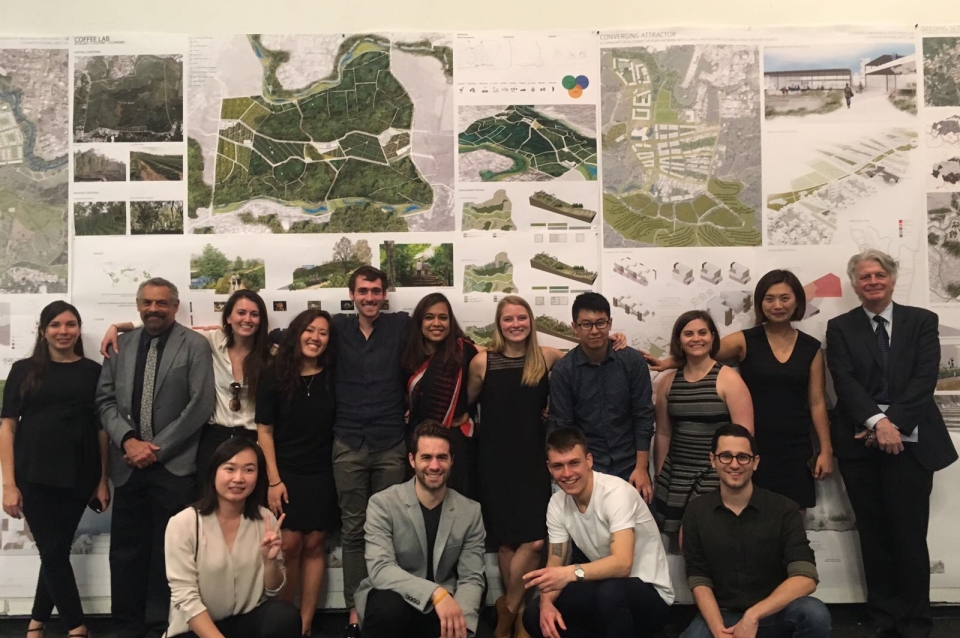May 16, 2018
Students Wrap Costa Rica Landscape Design Studio

Faculty member David Gouverneur (second from left), PennDesign Dean Fritz Steiner (right), and students in the interdisciplinary studio
Stuart Weitzman School of Design
102 Meyerson Hall
210 South 34th Street
Philadelphia, PA 19104

Faculty member David Gouverneur (second from left), PennDesign Dean Fritz Steiner (right), and students in the interdisciplinary studio
Michael Grant
mrgrant@design.upenn.edu
215.898.2539
As the spring semester was coming to a close earlier this month, the walls of Lower Gallery in Meyerson Hall were draped in maps, elevations, urban design and landscape renderings. On this particular day, students were joined by visitors from Costa Rica, and from the Urban Design Program at CCNY, for the final review in the spring studio Regenerating Urban Landscapes.
The studio focused on the Greater Metropolitan Area of San José, the capital city of Costa Rica. In a country known for biodiversity and tourism, students brought a critical eye to patterns of settlement and urbanization. After a 10-day trip to the country in February—during which students took part in lectures, field trips, and charrettes with local municipal staff, faculty, and students—they split into teams to complete their proposals, formulating replicable interventions for San José focused on enhancing the public realm. The projects addressed three main topics: a) taking advantage of large urban voids in the urban fabric by creating mixed-use districts, b) reconnecting urban patches, frequently severed by creeks, ravines, and infrastructural and social barriers, and c) keeping the city from encroaching on sensitive ecological and agricultural areas.
The studio was an interdisciplinary effort between the departments of landscape architecture, architecture, and city and regional planning at PennDesign. All of the teams had at least one student from each of the programs participating.
For Ramune Bartuskaite, a Master of Architecture student whose team focused on how to foster sustainable urbanization and improve agricultural production of a coffee farm, the work was about “holding the edge”, or improving the built environment while protecting both the coffee farm and the natural landscape beyond the settlements. Bartuskaite, who is also outreach chair for PennDesign Women in Architecture, said her team spent its time in San José asking a lot of questions of local planners, designers, and residents.
“Holding the edge,” or keeping the city from expanding endlessly, was one of the primary goals of the studio, said David Governeur, Associate Professor of Practice in the Department of Landscape Architecture. In Costa Rica and elsewhere in the region, urbanization is driven not only by formal development forces, but also by communities that construct their neighborhoods, create their own habitats, because they don’t have access to the traditional real-estate market.
Gouverneur developed the studio with fellow faculty member María Villalobos and their Costa Rican peers, three of whom are PennDesign alumni: Lucía Artavia (MCP’16), Daniel Fachler (MArch’17) and Dana Víquez (MLA’12).
Gouverneur, a former top planning official in Venezuela who has led a series of design studios focused on Latin American countries for PennDesign, said that visiting the city helps students develop a better understanding of its sites, topography, biodiversity, water systems, agricultural practices, urbanization trends, culture, politics, management, and so on. Cities are selected for a studio based on the promise of partnerships between the school and local institutions. Accessing internal support networks helps make the work go more smoothly, but it also gives students a more realistic sense of what’s possible in the realm of planning and design in a foreign city. Partners for the studio included the Costa Rica-based Universidad VERITAS, Tecnológico de Costa Rica, FORO Arquitectos, and officials from municipalities in and around San José—including Lucía Artavia (MCP’16), a former consultant for the Municipalidad de Curridabat.
The studio was dedicated to the memory of William Steinberg, a promising Penn freshman who died along with his family in a plane crash in Costa Rica in December.